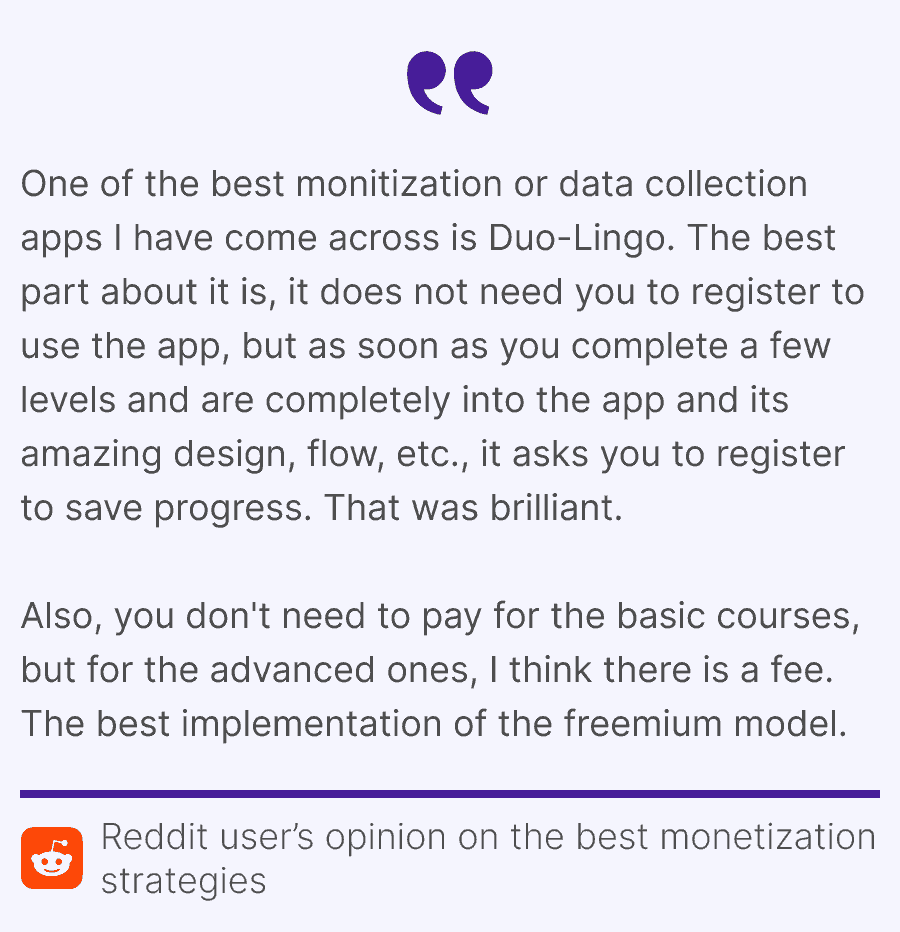Winning Users’ Hearts: Respectful App Monetization Tactics
Topic: Monetization

April 25, 2024
“Adobe has done something small but revolutionary in the area of timed trials. I recently downloaded the latest InDesign for a thirty day trial period. I used it to create a document, then forgot about it for a while. By the time I reopened the doc to finalize and print the thirty day period had elapsed.
Here's the ingenious part: Adobe treated me with respect. InDesign let me use the free trial "one last time." This let me finish my project and rush it out the door. You can bet I was favorably inclined to buy the product next time I needed it.”
I came across this post on Quora when I was analyzing people's opinions on the question: What's the best way to monetize apps? It made me realize that people care not only about the most favorable subscription terms but also about the way they feel when they use the app even if it’s a timed trial. “Adobe treated me with respect.” This was definitely one of the reasons why a person bought an Adobe product.
Adobe's approach of allowing the user to complete their project even after the trial period had elapsed is a great example of a user-friendly practice that can foster goodwill and increase the likelihood of users becoming paying customers.
Too often, companies prioritize aggressive monetization tactics over user experience, because their primary motivation is generating revenue and profits. I can’t blame them for that because many companies face immense pressure from shareholders and investors to maximize profits and revenues, often at the expense of other considerations like user satisfaction. Unfortunately, it can lead to frustration and a negative perception of the brand.
Key Considerations for User-Friendly Monetization
However, by taking a more respectful and considerate approach, as Adobe did in this case, companies can create a positive impression and nurture a sense of loyalty among users. Let me share with you some key considerations for app owners to follow Adobe's example:
- Transparency is essential. Therefore, don't surprise users with hidden fees after they've downloaded or started using the app. Be transparent about trial periods, pricing, in-app purchases and any limitations from the beginning.
- Flexibility is key. Offer grace periods or one-time extensions to accommodate users who need extra time for tasks or app evaluation.
- Personalization matters. Tailor the experience to individual users' needs and usage patterns. Avoid a one-size-fits-all approach that may frustrate or alienate certain user segments.
- Communicate the value proposition clearly. Highlight the benefits of becoming a paid subscriber or customer, emphasizing the features and support available upon upgrading.
- Continuous improvement is crucial. Gather user feedback and address concerns promptly, demonstrating a commitment to improve the monetization model based on user input.

Examples of Respectful Monetization Strategies
These are just basic guidelines. Here are some additional examples of how app owners can respect users in their monetization strategies:
Gradual feature unlocking: Instead of abruptly cutting off access after a trial period, progressively unlock more features as users continue to engage with the app over time. This allows them to experience the full value proposition gradually.
Limited free tier: Offer a free tier with basic functionality, but make advanced features available through a paid subscription. This respects that some users may only need core capabilities.
Family/group plans: Provide discounted pricing for families or groups, recognizing that multiple people may want to share an app subscription within a household or organization.
Student/educational discounts: Offer discounted pricing for students and educational institutions, making the app more accessible to those with limited budgets.
Grandfathering policies: If introducing pricing changes, allow existing users to keep their current pricing plan rather than forcing immediate changes upon them.
Data portability: Make it easy for users to export their data if they decide to discontinue the app, respecting their ownership of content they've created.
Clear cancellation process: Have a straightforward, transparent process for canceling subscriptions or memberships without obstacles or penalties.
Limited ads: For ad-supported models, limit the frequency and invasiveness of ads to avoid disrupting the user experience excessively.
Companies Implementing User-Friendly Monetization
Perhaps some of you reading this article will say: These are just words, but where are the real examples of applications that follow the above recommendations? You would be absolutely right. Any information is better supported by facts and examples. Here are some of them:
Spotify - They offer a free ad-supported tier with limited features, allowing users to try the service before upgrading to a premium subscription. Spotify also has student and family/group pricing plans.
Dropbox - Dropbox provides a free basic storage tier and easy upgrades to higher tiers as storage needs increase. They also offer generous referral bonuses to users for inviting friends.
Evernote - While their freemium model has evolved, Evernote allowed free users to continue using the legacy version even as they rolled out paid tiers for the newer app versions (grandfathering).
Trello - The project management app keeps its core features free for individuals, but offers upgraded tiers for teams/businesses at reasonable pricing with easy cancellation.
Grammarly - The popular writing assistant provides a free tier with core grammar/spelling checking. Upgrading unlocks more advanced features like plagiarism detection gradually.
Adobe Creative Cloud - As mentioned in the original example, Adobe extended grace periods for expiring trials to allow project completion before requiring purchasing.
Duolingo - The language learning app is completely free to use the core lessons, with paid upgrades to remove ads and access additional features like offline mode.
Calm - The meditation/sleep app gives free access to some content, while reserving full access and advanced courses as a paid subscription.

Conclusion
In today's highly competitive app marketplace, monetization strategies are crucial for business success. However, prioritizing short-term profits over user experience and respect can ultimately backfire, leading to high churn rates, negative brand perception, and the risk of being outpaced by more user-friendly competitors.
The example set by Adobe and other companies highlighted in this article demonstrates that it is possible to strike a balance between generating revenue and treating users with respect and consideration. By embracing transparency, flexibility, personalization, app owners can nurture long-term loyalty and increase the likelihood of converting trial users into paying customers.
Adopting user-friendly monetization practices can go a long way in creating a positive and sustainable relationship with your user base. In an increasingly crowded market, the companies that prioritize user respect and satisfaction are likely to be the ones that stand out and thrive in the long run.